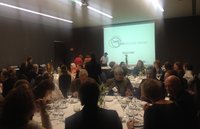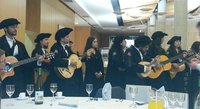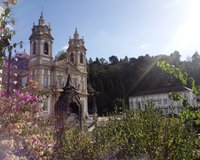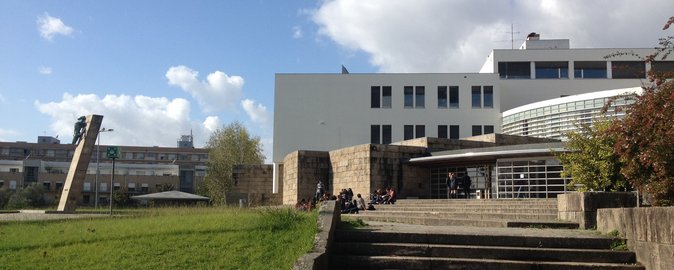The Braga Experience
IntlUni’s destination in the first week of November 2014 for the 5th All Partner Meeting was Braga, Portugal’s third largest city, and home to the University of Minho. Our hosts had prepared us in advance for the likelihood of autumnal storms in this north-westerly part of Portugal and we were not disappointed as the early bird arrivals on Monday were met with the full force of an Atlantic gale. Flying into Porto from all corners of Europe, including such differing climes as Cyprus and Finland, the turbulent conditions provided for delayed landings and a somewhat unnerving glimpse of white-topped Atlantic breakers as we circled to land.
2014.12.01 |


Networking & Joint Dinner with IntlUni partner representatives, external experts and evaluation board in Braga

Musical interlude by the Literatuna - Tuna de Letras da Universidade do Minho

The Literatuna

The beautiful church and sanctuary of Bom Jesus
Once on the ground, we were pleased to be whisked the short distance inland to Braga, which as our driver proudly informed us was at once district, municipality and city, in other words the administrative centre of the eponymous region, containing both Portugal’s oldest archdiocese and one of her newest and most dynamic universities. The combination of ancient and modern, tradition and innovation has been one of the recurrent themes of the university towns that we have so far encountered on the project and Braga is no exception.
The University of Minho has since its foundation in 1973 proved a magnet for young people and, being strong on research with well over a third of its students on postgraduate programmes, it is no surprise to find cutting-edge facilities such as the International Iberian Nanotechnology Laboratory within a stone’s throw of the Braga campus. A second campus is located in the city of Guimarães, which is known as Cidade Berço – ‘the cradle city’ – and considered the birthplace of Portuguese national identity. Its historical centre was designated a UNESCO World Heritage Site and in 2012 it was also nominated European Capital of Culture. As well as having two campuses in such prestigious locations, Minho University students also have ready access to two national parks in the region and it is hard to think of a more ideal study location.
In the first few days of the conference there was little chance for most participants to make the journey into the old city centre, but in the interludes we were expertly wined, dined and entertained on campus. One evening in particular will remain with us, as we were treated to a lively after-dinner concert of traditional Portuguese folk music performed by students dressed in the traje académico, the traditional but still popular academic gown. And as we walked each morning from our sumptuous hotel accommodation to the campus to take part in an intensive round of workshops, expert panel discussions and feedback sessions, we could also already see what we were missing beyond the campus. The weather cleared to reveal dotted on the hills surrounding the Minho campus some of the many churches for which Braga is justly famed. The Baroque hilltop sanctuary of Bom Jesus stood out among these and several of us duly took off once the opportunity arose to see its elaborate hillside gardens and fountains dedicated to the five senses, its nineteenth-century funicular, the oldest in the world operated by water counterbalancing, and of course to partake of its famed views over Braga.
There are by all accounts many allusions to places in Portuguese sayings and one in particular has come to be associated with Braga: ficar a ver Braga por um canudo, which roughly and somewhat obscurely to the foreign ear translates as ‘to get to see Braga through a straw’. This alludes to dashed expectations, to have Braga’s dreamy spires in view but never to arrive, and the city has thus become synonymous with an unattainable but constant ideal that belies the travails of history to which both Braga and Portugal have been exposed. A more straightforward saying also often trotted out is: Porto trabalha, Coimbra estuda, Braga reza e Lisboa diverte-se – "Porto works, Coimbra studies, Braga prays and Lisbon has fun." After our brief sojourn, I think we can vouch for the fact that alongside Braga’s religious heritage, and though the city may not exceed its more illustrious counterparts Lisbon, Porto and Coimbra regarding entertainment, industry and intellectual enterprise, it has enough of all of these more mundane virtues to easily transcend its often merely ecclesiastical reputation.


